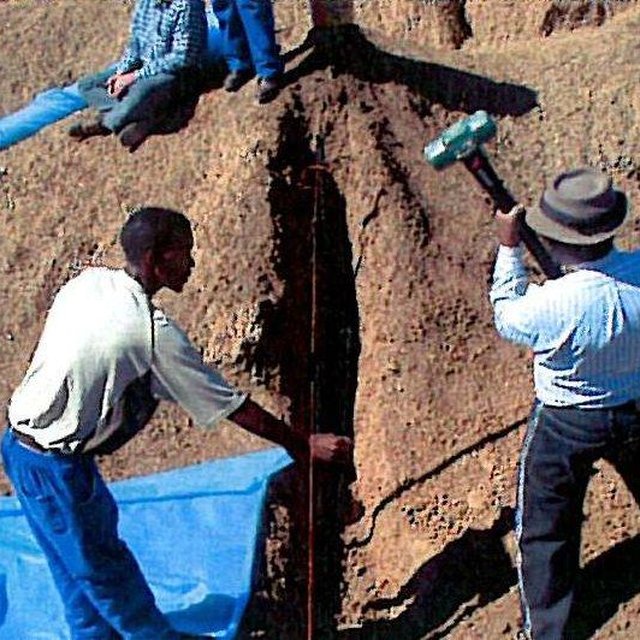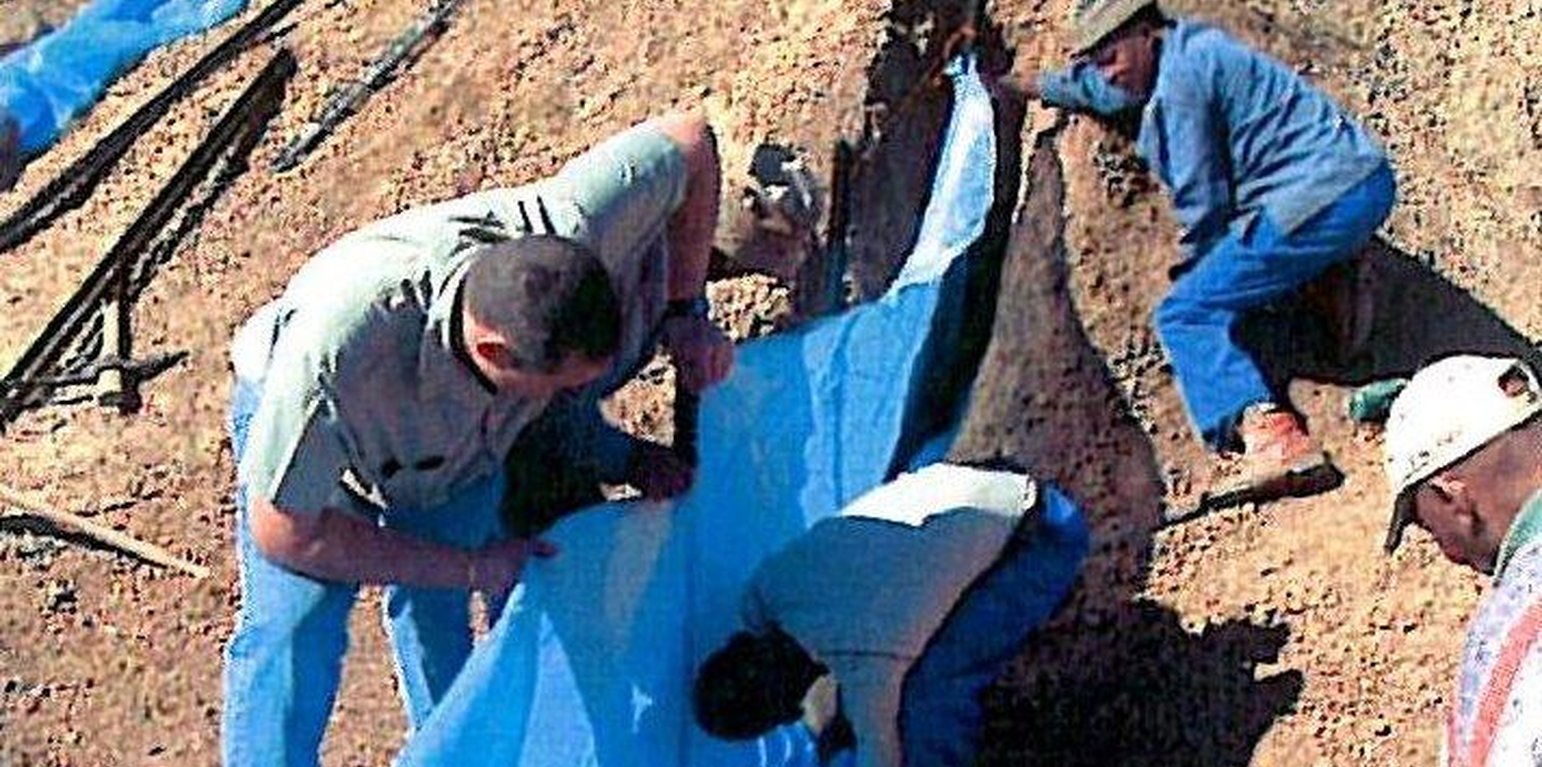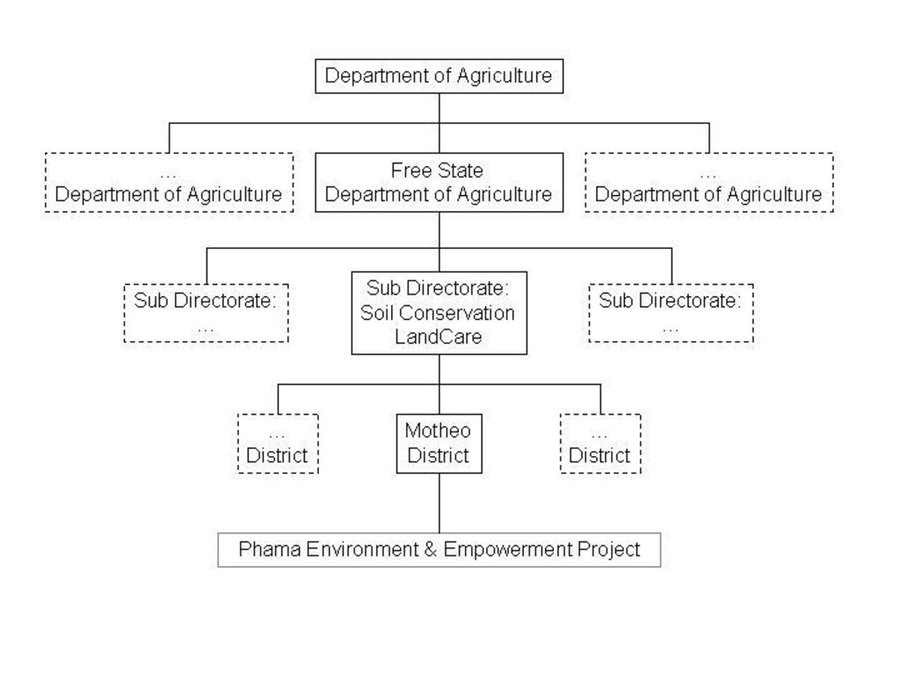Alternative and cost effective methods to control soil erosion
(ອາຟິກກາໃຕ້)
ຄຳອະທິບາຍ
Alternative and cost effective methods to control soil erosion
Aims / objectives: Research alternative, cost effective measures to control soil erosion Training of potentail contractor to errect soil conservation structures (Black Economic Empowerment) Wider acceptance and adoption of techniques by neighbouring communities
Methods: On-site research Literature research Needs analysis Trial and error Awareness ampaigns and information days Job creation to build structures
Stages of implementation: Control invader plants Literature research Design small structures Construction of erosion structures and stock watering Research on run-off trials Data analysis Information sharing
Role of stakeholders: Construction of small structures, controll invader plans, construction of stock watering
ສະຖານທີ່
![]()
ສະຖານທີ່: Ladybrandt, South Africa / Free State, ອາຟິກກາໃຕ້
ການຄັດເລືອກພື້ນທີ່ ທີ່ອີງໃສ່ຂໍ້ມູນທາງພູມີສາດ
ວັນທີເລີ່ມຕົ້ນ: 2006
ປີຂອງການສິ້ນສຸດ: 2009
ປະເພດຂອງແນວທາງ
-
ພື້ນເມືອງ / ທ້ອງຖີ່ນ
-
ການລິເລີ່ມ ພາຍໃນປະເທດ ທີ່ຜ່ານມາ / ນະວັດຕະກໍາ
-
ພາຍໃຕ້ໂຄງການ / ແຜນງານ

Soil erosion control

Soil erosion control
ເປົ້າໝາຍຂອງແນວທາງ ແລະ ການປົກປັກຮັກສາສິ່ງແວດລ້ອມ
ເປົ້າໝາຍ / ຈຸດປະສົງຫຼັກໃນການຈັດຕັ້ງປະຕິບັດແນວທາງ
The Approach focused mainly on SLM with other activities (Control invader and alien plants)
Research alternative, cost effective measures to control soil erosion Training of potentail contractor to errect soil conservation structures (Black Economic Empowerment) Wider acceptance and adoption of techniques by neighbouring communities
The SLM Approach addressed the following problems: Soil erosion Lost of grazing due to invader and alien plants Over grazing Lack of stock / grazing management Lack of knowledge
ເງື່ອນໄຂທີ່ສະໜັບສະໜູນໃຫ້ການຈັດຕັ້ງປະຕິບັດເຕັກໂນໂລຢີ ບົນພື້ນຖານແນວທາງ
ເງື່ອນໄຂທີ່ເຊື່ອງຊ້ອນໃຫ້ການຈັດຕັ້ງປະຕິບັດເຕັກໂນໂລຢີ ບົນພື້ນຖານແນວທາງ
-
ມີຄວາມສາມາດ / ເຂັ້າເຖິງຊັບພະຍາກອນດ້ານການເງິນ ແລະ ການບໍລິການ: Community has limited financial resource for conservation
Treatment through the SLM Approach: Project will provide funding for implementation of structures
-
ກ່ຽວກັບກົດໝາຍ (ສິດນໍາໃຊ້ດິນ, ສິດນໍາໃຊ້ນໍ້າ): The existing land ownership, land use rights / water rights moderately hindered the approach implementation Stock owners association rules was too rigid and land users are not owners (communage) - no private ownership. Members of cattle association differ.
-
ຄວາມຮູ້ກ່ຽວກັບການຄຸ້ມຄອງ ທີ່ດິນແບບຍືນຍົງ, ການເຂົ້າເຖິງການສະໜັບສະໜູນ ທາງດ້ານວິຊາການ: Community does not have technical know-how to design small structures
Treatment through the SLM Approach: Project provides technical inpust
-
ອື່ນໆ: Knowledge: Little knowledge about cost-effective measures to control soil erosion
Treatment through the SLM Approach: Project will provide funding for implementation of structures
ການມີສ່ວນຮ່ວມ ແລະ ບົດບາດຂອງພາກສ່ວນທີ່ກ່ຽວຂ້ອງທີ່ມີສ່ວນຮ່ວມ
ພາລະບົດບາດຂອງພາກສ່ວນທີ່ກ່ຽວຂ້ອງ ທີ່ມີສ່ວນຮ່ວມໃນການຈັດຕັ້ງປະຕິບັດແນວທາງ
| ແມ່ນໃຜ / ພາກສ່ວນໃດ ທີ່ເປັນເຈົ້າການ ໃນການຈັດຕັ້ງປະຕິບັດ ວິທີການ? |
ລະບຸ ພາກສ່ວນທີ່ກ່ຽວຂ້ອງ |
ພັນລະນາ ບົດບາດ ໜ້າທີ່ ຂອງພາກສ່ວນທີ່ກ່ຽວຂ້ອງ |
| ຜູ້ນໍາໃຊ້ດິນໃນທ້ອງຖິ່ນ / ຊຸມຊົນທ້ອງຖິ່ນ |
Stock owners, contractors and community members |
Men will do more physical work like building rock structures or fitting of rock gabions |
| ຜູ້ຊ່ຽວຊານ ການນຄຸ້ມຄອງ ທີ່ດິນແບບຍືນຍົງ / ທີ່ປຶກສາດ້ານກະສິກໍາ |
|
|
| ພະນັກງານຂັ້ນສູນກາງ (ຜູ້ວາງແຜນ, ຜູ້ສ້າງນະໂຍບາຍ) |
Provincial Department of Agriculture technical officials |
|
| ອົງການຈັດຕັ້ງ ສາກົນ |
|
|
ການລວບລວມເອົາຜູ້ນໍາໃຊ້ທີ່ດິນໃນທ້ອງຖິ່ນ/ຊຸມຊົນທ້ອງຖິ່ນ ໃນການຈັດຕັ້ງປະຕິບັດແນວທາງ ແຕ່ລະໄລຍະ
ບໍ່ມີ
ການບໍ່ປະຕິບັດ
ການຊ່ວຍເຫຼືອຈາກພາຍນອກ
ການຮ່ວມມື
ການນໍາໃໍຊ້ເອງ
ຕິດຕາມກວດກາ / ການປະເມີນຜົນ
ແຜ່ນວາດສະແດງ
Organogram QA RSA 072
ການຕັດສິນໃຈໃນການເລືອກເຕັກໂນໂລຢີ ການຄຸ້ມຄອງທີ່ດິນແບບຍືນຍົງ
ການຕັດສິນໃຈໂດຍ
-
ຜູ້ນໍາໃຊ້ດິນຜູ້ດຽວ (ການລິເລີ່ມດ້ວຍຕົນເອງ)
-
ຜູ້ນໍາໃຊ້ທີ່ດິນຫຼັກ, ການສະໜັບສະໜູນ ໂດຍຜູ້ຊ່ຽວຊານ ການນໍາໃຊ້ທີ່ດິນແບບຍືນຍົງ
-
ພາກສ່ວນກ່ຽວຂ້ອງທັງໝົດ, ເປັນສ່ວນໜຶ່ງ ຂອງວິທີທາງແບບມີສ່ວນຮ່ວມ
-
ຜູ້ຊ່ຽວຊານ ຫຼັກດ້ານການຄຸ້ມຄອງ ທີ່ດິນແບບຍືນຍົງ, ມີການຕິດຕາມປຶກສາຫາລືກັບຜູ້ນໍາໃຊ້ທີ່ດິນ
-
ຊຽ່ວຊານ ສະເພາະດ້ານການຄຸ້ມຄອງ ດິນແບບຍືນຍົງຜູ້ດຽວ
-
ນັກການເມືອງ / ຜູ້ນໍາ
ການຕັດສິນໃຈບົນພື້ນຖານ
-
ປະເມີນເອກກະສານ ຄວາມຮູ້ກ່ຽວກັບ ການຄຸ້ມຄອງ ທີ່ດິນແບບຍືນຍົງ (ຫຼັກຖານທີ່ຊ່ວຍໃນການຕັດສິນໃຈ)
-
ຜົນທີ່ໄດ້ຮັບ ຈາກການຄົ້ນຄວ້າ
-
ປະສົບການສ່ວນບຸກຄົນ ແລະ ຄວາມຄິດເຫັນ (ທີ່ບໍ່ເປັນເອກກະສານ)
ການສະໜັບສະໜູນເຕັກໂນໂລຢີ, ການສ້າງຄວາມອາດສາມາດ ແລະ ການຄຸ້ມຄອງຄວາມຮູ້
ກິດຈະກຳ ດັ່ງລຸ່ມນີ້ ແມ່ນເປັນພາກໜຶ່ງຂອງແນວທາງ
-
ການສ້າງຄວາມສາມາດ / ການຝຶກອົບຮົມ
-
ການບໍລິການໃຫ້ຄໍາປຶກສາ
-
ສະຖາບັນການສ້າງຄວາມເຂັ້ມແຂງ (ການພັດທະນາອົງການຈັດຕັ້ງ)
-
ຕິດຕາມກວດກາ ແລະ ປະເມີນຜົນ
-
ການຄົ້ນຄວ້າ
ການສ້າງຄວາມອາດສາມາດ / ຝຶກອົບຮົມ
ໄດ້ສະໜັບສະໜູນຝຶກອົບຮົມໃຫ້ແກ່ພາກສ່ວນກ່ຽວຂ້ອງດັ່ງລຸ່ມນີ້
-
ຜູ້ນໍາໃຊ້ດິນ
-
ພະນັກງານພາກສະໜາມ / ທີ່ປຶກສາ
-
land user
ຮູບແບບການຝຶກອົບຮົມ
-
ການເຮັດຕົວຈິງ
-
ຕົວຕໍ່ຕົວ
-
ເນື້ອທີ່ສວນທົດລອງ
-
ກອງປະຊຸມ
-
ຫຼັກສູດ
ກວມເອົາຫົວຂໍ້
Construction of SWC structures and training on veld management. Control of invader plants.
ການບໍລິການທາງດ້ານການໃຫ້ຄໍາປຶກສາ
ໄດ້ຮັບການບໍລິການທາງດ້ານການໃຫ້ຄໍາປຶກສາ
-
ໃນພື້ນທີ່ຂອງຜູ້ນໍາໃຊ້ດິນ
-
ສູນຄົ້ນຄວ້າ
Name of method used for advisory service: Cost effective erosion control and veld management; Key elements: Awareness, Meetings formal and informal, Farm visits and participatory approaches
Advisory service is quite adequate to ensure the continuation of land conservation activities; Empowered through project to continue with SWC activities
ການຕິດຕາມ ແລະ ປະເມີນຜົນ
technical aspects were regular monitored through measurements; indicators: Functionaing (effectiveness) of structures
socio-cultural aspects were ad hoc monitored through observations; indicators: Adoption of technology
area treated aspects were regular monitored through measurements; indicators: Area treatede / conserved
no. of land users involved aspects were regular monitored through measurements; indicators: No. of community actively involved
management of Approach aspects were regular monitored through measurements; indicators: Maintenance and acceptance
There were few changes in the Approach as a result of monitoring and evaluation: Redesign of small structures and different application of materials
ການຄົ້ນຄວ້າ
ການວິໄຈໄດ້ຮັບການຮັກສາຫົວຂໍ້ຕໍ່ໄປນີ້
-
ສັງຄົມ
-
ເສດຖະສາດ / ການຕະຫຼາດ
-
ລະບົບນິເວດ
-
ເຕັກໂນໂລຢີ
Run-off trials and participatory approaches for community participation
Research was carried out on-farm
ການສະໜັບສະໜູນທາງດ້ານການເງິນ ແລະ ອຸປະກອນຈາກພາຍນອກ
ງົບປະມານປະຈຳປີ ໃນກິດຈະກຳ ການຄຸ້ມຄອງທີ່ດິນແບບຍືນຍົງ ທີ່ເປັນສະກຸນເງິນໂດລາ
-
< 2,000
-
2,000-10,000
-
10,000-100,000
-
100,000-1,000,000
-
> 1,000,000
Precise annual budget: n.a.
Approach costs were met by the following donors: government (Agricultural Research Council): 80.0%; national non-government: 15.0%; local community / land user(s): 5.0%
ການບໍລິການ ຫຼື ສິ່ງກະຕຸກຊຸກຍູ້ ດັ່ງລຸ່ມນີ້ ແມ່ນໄດ້ສະໜອງໂດຍຜູ້ນຳໃຊ້ທີ່ດິນເອງ
-
ການສະໜັບສະໜູນ ທາງດ້ານການເງິນ / ອຸປະກອນ ສະໜອງໃຫ້ແກ່ຜູ້ນໍາທີ່ດິນ
-
ຫຼຸດປັດໃຈນໍາເຂົ້າ
-
ສິນເຊື່ອ
-
ສິ່ງຈູງໃຈ ຫຼື ເຄື່ອງມືອື່ນໆ
ເງິນສະໜັບສະໜູນອຸປະກອນ / ສະໜອງໃຫ້ຜູ້ຊົມໃຊ້ທີ່ດິນ
ງົບປະມານບາງສ່ວນ
ງົບປະມານເຕັມສ່ວນ
ອຸປະກອນ: ເຄື່ອງກົນຈັກ: ເຄື່ອງມື
ກະສິກໍາ: ແນວພັນ, ແກ່ນພັນ: ຝຸ່ນ, ປຸ໋ຍ
ແຮງງານຂອງຜູ້ນໍ້າໃຊ້ທີ່ດິນ
-
ການອາສາ
-
ລ້ຽງເຂົ້າ - ອາຫານ
-
ຈ່າຍເປັນເງິນສົດ
-
ໄດ້ຮັບການສະໜັບສະໜູນ ອຸປະກອນດ້ານອື່ນ
ການວິເຄາະຜົນກະທົບ ແລະ ສະຫຼຸບລວມ
ຜົນກະທົບຂອງການນໍາໃຊ້ແນວທາງ
ບໍ່
ມີ, ໜ້ອຍໜຶ່ງ
ມີ, ພໍສົມຄວນ
ມີ, ຫຼາຍ
ການຈັດຕັ້ງປະຕິບັດ ວິທີທາງ ສາມາດຊ່ວຍຜູ້ນໍາໃຊ້ທີ່ດິນ ໃນການຈັດຕັ້ງປະຕິບັດ ແລະ ບໍາລຸງຮັກສາ ເຕັກໂນໂລຢີ ການຄຸ້ມຄອງ ທີ່ດິນແບບຍືນຍົງໄດ້ບໍ?
Use of silt fences and soil boxes adapted by land users
ການຈັດຕັ້ງປະຕິບັດ ວິທີທາງ ສາມາດປັບປຸງ ປະເດັນການຖືຄອງທີ່ດິນ / ສິດທິໃນການນໍາໃຊ້ທີ່ດິນ ທີ່ເຊື່ອງຊ້ອນໃນການຈັດຕັ້ງປະຕິບັດ ເຕັກໂນໂລຢີ ການຄຸ້ມຄອງ ທີ່ດິນແບບຍືນຍົງໄດ້ບໍ?
Improve general awareness and commitment of cattle owners
The problem is unlikely to be overcome in the near future. Too many people - too much pressure on the land and unwillingness of local authorities to get involved.
Did other land users / projects adopt the Approach?
Commercial farmers who visited project adopted and implemented some of the SWC methods deomnstrated / researched in projects.
ສິ່ງກະຕຸກຊຸກຍູ້ໃຫ້ຜູ້ນໍາໃຊ້ທີ່ດິນ ໃນການປະຕິບັດການຄຸ້ມຄອງທີ່ດິນແບບຍືນຍົງ
ຄວາມຍືນຍົງຂອງການຈັດຕັ້ງປະຕິບັດກິດຈະກໍາຂອງແນວທາງ
ຜູ້ນໍາໃຊ້ທີ່ດິນ ສາມາດຈັດຕັ້ງປະຕິບັດຕາມແນວທາງໄດ້ເອງບໍ່ (ໂດຍປາດສະຈາກການສະໜັບສະໜູນຈາກພາກສ່ວນພາຍນອກ)?
ບົດສະຫຼຸບ ແລະ ບົດຮຽນທີ່ໄດ້ຮັບ
ຄວາມເຂັ້ມແຂງ: ທັດສະນະມູມມອງ ຂອງຜູ້ນໍາໃຊ້ທີ່ດິນ
-
Temporary job creation (How to sustain/ enhance this strength: Not sustainable if there are no follow up projects)
-
Improved natural resource condition (How to sustain/ enhance this strength: Maintain structures / control invasive plants / implement grazing system)
-
Contractor empowered with unique SWC methods - niche market (How to sustain/ enhance this strength: Continue empowerment with training and informatin sharing. He has to advertise his services.)
ຄວາມເຂັ້ມແຂງ: ທັດສະນະມຸມມອງ ຂອງຜູ້ປ້ອນຂໍ້ມູນເອງ
-
Empowerment of community with knowledge and skills (How to sustain/ enhance this strength: Ensure the adaption and implementation of structures and maintenance of current structures)
-
Empowerment of contractor (How to sustain/ enhance this strength: Follow up projects and work for private sector)
-
Holistic approach towards environmental problems (How to sustain/ enhance this strength: systems approach deal with real causes of degradation. More partnerships and more stakholders involved.)
-
Cost effective methods to control soil conservation (How to sustain/ enhance this strength: More on-site research andawareness of test method technologies and approaches.)
-
Alien plant control (How to sustain/ enhance this strength: Follow up and more research monitoring and evaluation)
-
Improved veld management (How to sustain/ enhance this strength: Monitoring and evaluation)
ຈຸດອ່ອນ / ຂໍ້ເສຍ / ຄວາມສ່ຽງ: ທັດສະນະມູມມອງ ຂອງຜູ້ນໍາໃຊ້ທີ່ດິນວິທີການແກ້ໄຂແນວໃດ
-
No ownership of land (land tennure - commonage)
Review use of commonages - need new policy
-
Low educational levels - difficalt to train, learn new technologies
Continue education, training and awareness
-
Contractor needs administrative empowerment
Capacity building
ຈຸດອ່ອນ / ຂໍ້ເສຍ / ຄວາມສ່ຽງ: ທັດສະນະມຸມມອງ ຂອງຜູ້ປ້ອນຂໍ້ມູນເອງວິທີການແກ້ໄຂແນວໃດ
-
Lack of local expertise in SWC structures / small structures
Continue with researh and information shareing at national / international level.
-
Capacity on project management side
More and better trained project managers.
-
Financial support: Huge problem - small budget
Convince national donors about extent and degree of degradation problems. Look for private donors.
-
Politics exclude commercial farmers - project coud have bigger impact
Decision for restoration and conservation must be based on ecological needs and not political agendas.
ເອກກະສານອ້າງອີງ
ວັນທີຂອງການປະຕິບັດ: April 21, 2009
ປັບປຸງລ່າສຸດ: June 18, 2017
ບຸກຄົນທີ່ສໍາຄັນ
-
Christiann Smith (smith@agric.fs.gov.za) - ຜູ້ຊ່ຽວຊານ ດ້ານການຄຸ້ມຄອງ ທີ່ດິນແບບຍືນຍົງ
ການບັນຍາຍລາຍລະອຽດ ໃນຖານຂໍ້ມູນ ຂອງ WOCAT
ຂໍ້ມູນການເຊື່ອມໂຍງຂໍ້ມູນການຄຸ້ມຄອງການນໍາໃຊ້ດິນແບບຍືນຍົງ
ເອກກະສານ ແມ່ນໄດ້ອໍານວຍຄວາມສະດວກໂດຍ






